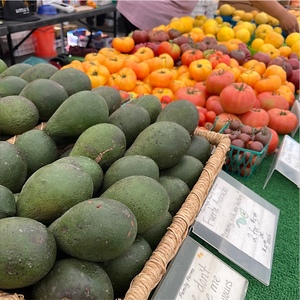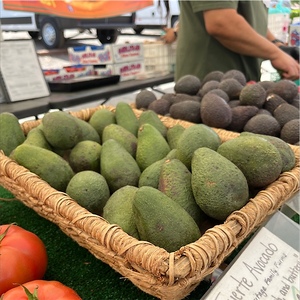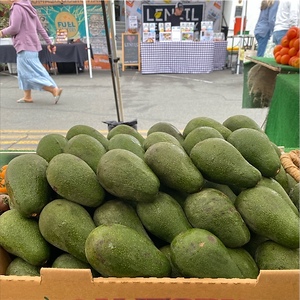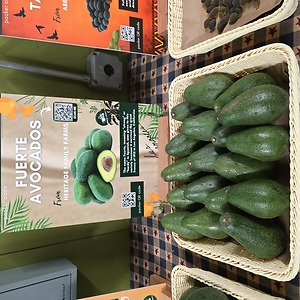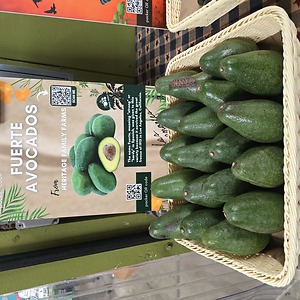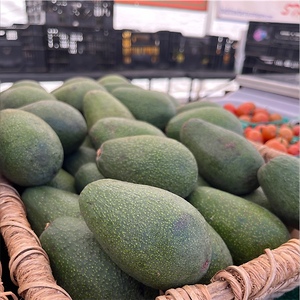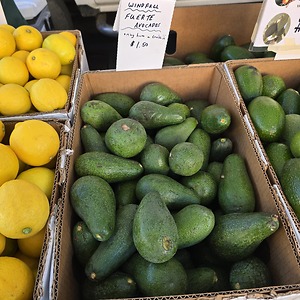

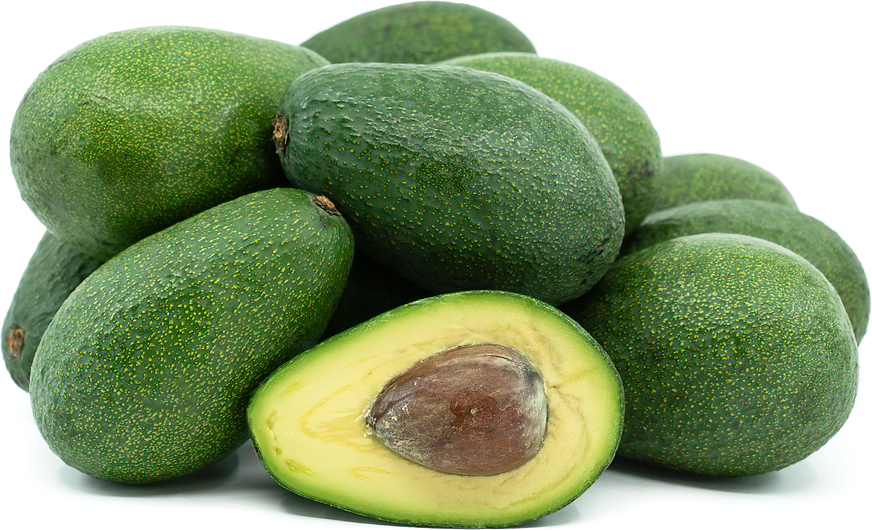
Fuerte Avocados
Estimated Inventory, ea : 0
Description/Taste
Fuerte avocados have a pear-like shape, similar to that of an Ettinger or Pinkerton avocado. They vary in size significantly, weighing 170 to 450 grams, and have a dark green hue with small yellow dots, developing occasional black spots when they become very ripe. Their medium-thin skin has a bumpy yet smooth and pliable texture, not adhering well to the flesh but allowing it to peel easily. The light green flesh of Fuerte avocados is oily with a creamy, smooth texture and relatively little fiber. Inside the flesh is a large, brown, teardrop-shaped seed that occupies a significant portion of the bottom of the fruit. Fuerte avocados have a rich, buttery, and creamy flavor with notes of hazelnut.
Seasons/Availability
Fuerte avocados are available from late fall to spring.
Current Facts
The botanical name for Fuerte avocados is Persea americana and they’re members of the Lauraceae, or Laurel family, which also includes cinnamon, sassafras, and bay leaf. The name "Fuerte," meaning "strong" or "hardy" in Spanish, was given to this variety due to its cold tolerance and vigorous growth. Avocados are technically classified as berries and are divided into three races: Mexican, Guatemalan, and West Indian. While each has distinctive features, cross-pollination permits the development of unlimited varieties, which is the case with Fuerte because they are a mix of Mexican and Guatemalan avocados. This variety is primarily valued for its culinary use, especially when eaten raw. It is also popular for making avocado oil.
Nutritional Value
Fuerte avocados are a good source of vitamins C, E, and K. These vitamins are important for tissue growth, collagen production, iron absorption, teeth maintenance, bone metabolism, immune function, blood clotting, and protection against free radicals and oxidative damage. They contain B vitamins Thiamin, Riboflavin, and Niacin, which promote energy production, fat metabolism, nerve function, digestion, and skin health. Fuerte avocadoes are high in protein and potassium, particularly for a fruit. These nutrients repair tissues, produce hormones, promote heart and muscle function, and help reduce blood pressure. This fruit also possess magnesium to control blood glucose and folate to create red blood cells. Fuerte avocados have monounsaturated fat, such as oleic acid, that may help lower LDL cholesterol in the body while raising the levels of healthy HDL cholesterol.
Applications
Fuerte avocados are most often used raw. Generally, they should not be exposed to direct heat and should instead be added to hot dishes once they're finished cooking. They may be breaded and deep-fried with careful attention. This variety’s soft, spreadable flesh can be used as a substitute for butter on toast or in sandwiches. They can be cut into slices and used as a topping for chicken penne pasta, tacos, grain bowls, omelets, and sushi. Fuerte avocados can be mashed together with sour cream and lemon juice to spread on crackers or incorporated into a side salad by combining them with baby spinach leaves, roasted pecan nuts, and grilled prosciutto. Fuerte avocados pair well with acidic fruits and vegetables like citrus, tomatoes, and pineapple, as well as with acidic dressings. They are also complemented by the flavors of balsamic vinegar, lemon, lime, honey, pistachios, chives, turnips, radishes, carrots, broccoli, celery, kale, coconut, sundried tomatoes, steak, pork, chicken, shrimp, and quinoa. Fuerte avocados should be stored at room temperature until ripe, as they will not continue to ripen when they are refrigerated. Whole ripe avocados will keep for two to three days in the refrigerator, while cut avocados will last for just a day or two.
Ethnic/Cultural Info
Fuerte avocados were originally grown from the seedlings of a tree found growing in Atlixco in the Puebla State of Mexico. Atlixco is known for producing high-quality, large-fruited avocados from both the Mexican and Guatemalan species. The garden where the Fuerte seedling was found is visible from the summit of the Cerro de San Miguel, a hilltop chapel in the city. This garden forms a half-mile-wide belt of densely planted avocado trees, surrounded by other crops like wheat and alfalfa. In addition to its abundance of fruit trees, Atlixco is known as "The City of Flowers" because of the many varieties of flowers that flourish throughout the area, including geraniums, gladiolas, roses, and chrysanthemums.
Geography/History
Fuerte avocados were first planted by American explorer Carl Schmidt at the West Indian Gardens nursery in Altadena, California. He had traveled to southern Mexico in 1911 in search of new varieties and captured samples from nearly thirty varieties of avocado trees from Atlixco, Mexico. He then shipped them back to Altadena, where most of them failed to adapt to the soil and climate, except for the Fuerte. Avocado trees weren't cultivated in California until the 1800s, and the only variety to survive a severe frost in Southern California during the winter of 1914 was the Fuerte. They became the cultivar upon which the California avocado industry was built, making up two-thirds of California avocado production by the 1950s and then spreading to South Africa, Australia, and Spain. Eventually, Fuerte avocados were displaced by the Hass avocado, which boasted a thicker skin and better ability to handle shipping to distant marketplaces. While Fuerte avocado trees are fairly resistant to cold, they do best in warm climates with daily highs above 70°F and nightly lows above 50°F. They struggle in cool coastal regions and are better suited for inland areas. Fuerte avocados aren’t commonly found in grocery stores, but they may be purchased from trees to grow in home gardens or sourced from specialty stores and farmers' markets.
Recipe Ideas
Recipes that include Fuerte Avocados. One
Podcast



